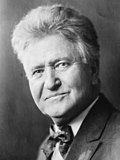| |||||||||||||||||||||||||||||||||
| |||||||||||||||||||||||||||||||||
| |||||||||||||||||||||||||||||||||
| |||||||||||||||||||||||||||||||||
| Elections in Vermont |
|---|
 |
The 1924 United States presidential election in Vermont took place on November 4, 1924, as part of the 1924 United States presidential election which was held throughout all contemporary 48 states. Voters chose four representatives, or electors to the Electoral College, who voted for president and vice president.
Contents
Vermont voted overwhelmingly for the Republican nominee, incumbent President Calvin Coolidge of Massachusetts, over the Democratic nominee, Ambassador John W. Davis of West Virginia. Coolidge ran with former Budget Director Charles G. Dawes of Illinois, while Davis ran with Governor Charles W. Bryan of Nebraska. Also in the running that year was the Progressive Party nominee, Senator Robert M. La Follette of Wisconsin and his running mate Senator Burton K. Wheeler of Montana.
Coolidge won in a massive landslide, taking 78.22% of the vote, while Davis took 15.67% for a Republican victory margin of 62.55%. La Follette came in a distant third, with 5.79%. Coolidge won every town in his birth state except for Lemington in Essex County which narrowly went to John W Davis. Vermont historically was a bastion of Northeastern Republicanism, and by 1924 it had gone Republican in every presidential election since the founding of the Republican Party. From 1856 to 1920, Vermont had had the longest streak of voting Republican of any state, having never voted Democratic before, and this tradition continued amidst a second consecutive nationwide Republican landslide in 1924.
The 1920s were a fiercely Republican decade in American politics, and Vermont in that era was a fiercely Republican state in presidential elections. The economic boom and social good feelings of the Roaring Twenties under popular Republican leadership virtually guaranteed Calvin Coolidge an easy win in the state against the conservative Southern Democrat John Davis, [1] who had practically no appeal in Northern states like Vermont. In fact, with only 15.67% of the popular vote, Davis' performance in Vermont was the weakest of any Democratic presidential candidate in the state to date.
Calvin Coolidge also enjoyed a unique personal popularity which helped him in the state. [2] Coolidge was the epitome of a traditional New England Yankee, having been born in the small-town of Plymouth Notch, Vermont, and establishing his political career nearby as Governor of Massachusetts. Thus Coolidge remained especially popular with voters across New England, but especially in his birth state, and Vermont would give him an even more overwhelming victory than it had given to Warren G. Harding four years earlier. Even with the strong third party candidacy of Robert La Follette, Coolidge in 1924 managed to gain in both vote share and margin over Harding's landslide showing in the state in 1920. Coolidge was particularly popular in Windsor County, his birthplace, which gave him over 88% of the vote and was his strongest county in Vermont and his fifth-strongest nationwide.
Partly as a consequence of Coolidge's personal popularity in the state, Robert La Follette was not able to attract a large percentage of the vote in Vermont. La Follette had been a Republican Senator prior to mounting his Progressive Party presidential campaign, and in working-class Mid-Atlantic [3] and rural German and Scandinavian-American areas [4] was able to peel off a large proportion of progressive Republican voters. However, Vermont Republican voters remained overwhelmingly loyal to Coolidge. Thus while taking 16.61% nationally, La Follette only received 5.79% of the vote in Vermont.





